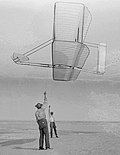Lift (force)
The force of lift is the upward force that keeps an aircraft in the air. It's an aerodynamic force that's generated when a fluid, like air, flows past a solid object, like an airplane wing:
The most common type of lift is that of a wing of an aircraft. But there are many other common uses such as propellers on both aircraft and boats, rotors on helicopters, fan blades, sails on sailboats, and wind turbines.
While the common meaning of the term "lift" suggests an "upwards" action, lift can be in any direction. For instance, for a sail the lift is horizontal, and for the wing on a race car the lift is down.
There are a number of ways of explaining the production of lift; some are more complicated than others, some have been shown to be false. The simplest explanation is that the wing deflects air downward, and the reaction pushes the wing up.
Lift (force) Media
The 1902 Wright Glider shows its lift by pulling up
Lift is defined as the component of the aerodynamic force that is perpendicular to the flow direction, and drag is the component that is parallel to the flow direction.
Other websites
- How Airplanes Fly: A Physical Description of Lift
- NASA tutorial, with animation, describing lift Archived 2009-03-09 at the Wayback Machine
- Description on one very common incorrect explanation of lift Archived 2014-04-27 at the Wayback Machine
- Discussion of the apparent "conflict" between the various explanations of lift Archived 2006-02-07 at the Wayback Machine
- Explanation of Lift with animation of fluid flow around an airfoil
- A treatment of why and how wings generate lift that focuses on pressure. Archived 2006-12-19 at the Wayback Machine








